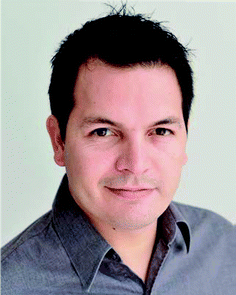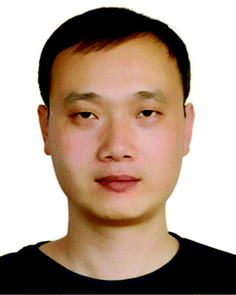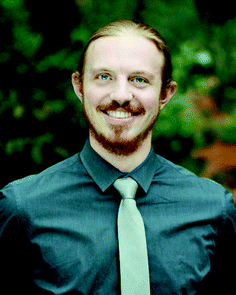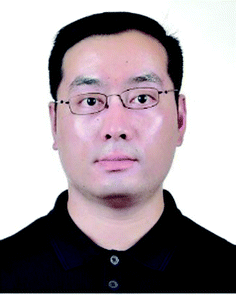Journal of Materials Chemistry B profiles: Contributors to the Emerging Investigators 2017 issue
Marcelo Calderón is an Assistant Professor for Macromolecular and Organic Chemistry at the Department of Biology, Chemistry, and Pharmacy from the Freie Universität Berlin, Germany. He received his PhD in Organic Chemistry in 2007 from the National University of Córdoba, Argentina, under the supervision of Professor Miriam Strumia. In 2007 he joined the Research Group of Professor Rainer Haag at the Freie Universitat Berlin for his postdoctoral work, where he pursued the development of polymer–drug conjugates for the passive targeted delivery of drugs, genes and imaging probes. Since 2011 he has been a member of the Helmholtz Virtual Institute (HVI) Multifunctional Biomaterials for Medicine that explores the complex processes involved in protein adsorption on polymers for biomedical applications.
Yi Cao received his Bachelor's degree in 2001 and Master's degree in 2004 from Nanjing University. He then obtained his PhD in 2009 from the University of British Columbia. After a one-year postdoc at the same place, he started his independent career at the Department of Physics, Nanjing University as a full Professor. He was the recipient of the 2014 IUPAP Young Scientist Prize in Biological Physics for his contributions to the study of nanomechanics and mechanical unfolding dynamics of proteins using single molecule atomic force microscopy. His current research focuses on the application of the single molecule method and molecular engineering to designing biomaterials with tailored mechanical properties.
Mónica Carril received her PhD in Chemistry from the University of the Basque Country (UPV/EHU, 2006) in the field of synthetic organic chemistry. After two postdoctoral stays in Germany with Professor Bolm and Professor Kühn (RWTH Aachen and TUM Munich, respectively) dealing with catalysis, she joined CIC biomaGUNE in Spain. In 2013, she was granted an Ikerbasque tenure-track research position and since then her research interests have been in the field of nanoparticles as contrast agents for magnetic resonance imaging (MRI). Recently, she has focused her attention on the design of fluorinated probes for 19F-MRI.
Cole A. DeForest is an Assistant Professor in the Department of Chemical Engineering at the University of Washington. He received a BSE (Magna Cum Laude) in Chemical Engineering/Material Science (2006) from Princeton University, and subsequently earned his PhD in Chemical/Biological Engineering (2011) from the University of Colorado before performing postdoctoral studies at the California Institute of Technology. His research aims to develop dynamically tunable biomaterial platforms that aid in understanding 4D biological processes and to exploit this ascertained information in the engineering of functional human tissue.
Xin Du received his BSc in 2007 from Nankai University and PhD degree in Physical Chemistry in 2012 from Technical Institute of Physics and Chemistry (TIPC), Chinese Academy of Science (CAS). He pursued his research as a postdoctoral researcher at School of Chemical Engineering in The University of Adelaide, Australia, from 2012 to 2014. Then, he joined the Research Center for Bioengineering and Sensing Technology, University of Science & Technology Beijing. Now he is an Associate Professor. He has published more than 60 peer reviewed journal articles with over 1500 citations. His research interests focus on the design and controllable synthesis of novel nano-structured silica materials and silica-based composites as advanced drug/gene delivery nano-systems, nano-catalysts with high activity and stability and multifunctional antireflection nano-coatings with superhydrophilic antifogging or superhydrophobic self-cleaning properties.
Eva Hemmer received her PhD in 2008 from Saarland University (Germany) under the mentorship of Professor Sanjay Mathur. From 2009 to 2012, she worked on lanthanide-based nanoparticles for near-infrared bioimaging with Professor Kohei Soga at the Tokyo University of Science. In 2013 she was awarded a Feodor Lynen Research Postdoctoral Fellowship to develop lanthanide-based nanothermometers in the groups of Professors Fiorenzo Vetrone and François Légaré at INRS-EMT (Université du Québec, Canada). In 2016, she joined the University of Ottawa as Assistant Professor at the Department of Chemistry and Biomolecular Sciences, where she is working on lanthanide-based nanocarriers for biomedical and energy conversion applications.
Takashi Hoshiba received his PhD degree in 2007 from Tokyo Institute of Technology. He worked at the National Institute for Materials Sciences (NIMS) as a postdoctoral fellow (2007–2009) and as a Research Fellow of the Japan Society for Promotion of Science (2009–2011). He has been at Yamagata University as a Research Assistant Professor (2011–2014) and as a Research Associate Professor (2014–present). Also, he has been a Guest Researcher in NIMS (2013–present). His current research interests are the extracellular matrix as a biomaterial in tissue engineering/regenerative medicine and cancer.
Jae-Young Lee is an Associate Professor of the School of Materials Science and Engineering, Gwangju Institute of Science and Technology (GIST), Republic of Korea. He received BS and MS degrees in Chemical Technology from Seoul National University in 1997 and 1999, respectively. He worked as a research manager in LG Life Science Ltd from 1999 to 2005. He received his PhD from The University of Texas at Austin in 2010. He conducted his postdoctoral research at University of California Berkeley with an American Heart Association (AHA) postdoctoral fellowship. He joined GIST in 2012. His current research focuses on the development of functional biomaterials that can improve biomaterial–cell interactions for various uses. His research interests include designs of surface modification of implantable bio-electrodes, tissue engineering scaffolds and nano-biomaterials for therapeutic applications.
Tung Chun Lee received his BSc in Chemistry from University of Hong Kong in 2005 and his PhD in Chemistry from University of Cambridge in 2012. He was a Postdoctoral Fellow at the Max Planck Institute for Intelligent Systems from 2011 to 2014. In 2014, he joined University College London as a Lecturer and started his independent academic career. His research interests include exotic nanoparticles, nanofabrication, nanochemistry, active matter and supramolecular chemistry. Currently, he has 30 publications in reputable journals.
Fernando López-Gallego was born and raised in Villaminaya, a small town in the region of La Mancha (Spain), the land where Don Quixote's famous adventures took place. In 2007, he completed his doctoral studies under the guidance of Professor Guisan and Professor Fernández-Lafuente at the Institute of Catalysis (ICP-CSIC) in Madrid, receiving his PhD from the University Autonoma of Madrid. He then joined Professor Schmidt-Dannert's laboratory at the University of Minnesota (USA) as a postdoctoral researcher. Later on, he moved to the REPSOL R&D Center in Madrid where he worked at the implementation of biocatalysis in industrial processes. In 2013, he was awarded an IKERBASQUE Fellowship (tenure-track grant) and started his independent career in the Basque Country. He is currently leading the Heterogeneous Biocatalysis Lab at CIC biomaGUNE (Donostia, Spain), where he merges enzymes with advanced materials to fabricate the next generation of multi-functional heterogeneous biocatalysts.
Paola Luciani has been an Associate Professor for Phospholipids in Drug Development at the Institute of Pharmacy, University of Jena, Germany, since September 2015. She obtained her MSc and PhD in Chemical Sciences in 2002 and 2006 respectively, and subsequently worked as a Research Fellow on Colloidal Sciences at the University of Florence before moving to Switzerland. She then joined the group of Professor Leroux at the ETH Zurich, where she spent six years working as a postdoctoral scientist and group leader on drug formulation and delivery. Her research focuses on the design and characterization of lipid-derived delivery systems for drug delivery and diagnosis.
Jonathan Massera is an Associate Professor (Tenure Track) at Tampere University of Technology (BioMediTech institute and Faculty of Biomedical Sciences and Engineering). He is also an Academy Research Fellow, appointed by the Academy of Finland (2014–2019). He obtained his MSc and Engineering degree as part of a dual degree between Polytech’Montpellier, France and Politecnico di Torino, Italy. He defended his PhD thesis in 2009, at Clemson University, SC, USA. Today, his group is part of the Biomaterials and Tissue Engineering team. His research focuses on glasses with application in the medical field, primarily in bone reconstruction. Some the interests of his research group are (i) phosphate and borosilicate bioactive glasses, fibers and scaffolds, (ii) glasses with thermal properties enabling hot forming, (iii) impact of controlled crystallization on the bioactivity and (iv) bioimaging of implants. The bioactive glasses developed are used as such or as part of a composite.
Yukiko T. Matsunaga is an Assistant Professor in the Institute of Industrial Science (IIS) at the University of Tokyo. She obtained her PhD in Material Science and Engineering from Tsukuba University in 2007. She carried out her postdoctoral research at Tokyo Women's Medical University and The University of Tokyo. Her research interests include smart polymers for biomedical applications, bottom-up tissue engineering and microdevices.
Javier Montenegro received his PhD (2009) from the University of Santiago de Compostela (USC, Professor Susana López). He was a visiting scientist in the groups of Professor Steven Ley (Cambridge University) and Professor Reza M. Ghadiri (Scripps). In 2009 he moved to the University of Geneva for three years of postdoctoral studies with Professor Stefan Matile. In 2012 he obtained a Juan de la Cierva fellowship (Professor Juan R. Granja) and in 2014 a Ramon y Cajal contract at the Organic Chemistry Department and the CIQUS at USC. In 2015 he was awarded with a Starting Grant from the European Research Council (ERC). His research interests lie at the interphase between organic synthetic and supramolecular chemistry applied to biological systems and the discovery of new materials. His current projects are focused in the topological control of supramolecular assemblies for broad applications such as differential sensing, controlled delivery and tubular-templated composites.
Jonathan Pokorski began his scientific career by earning his BS in Biochemistry from UCLA in 2002. He received his PhD degree in chemistry from Northwestern University in 2007, studying peptidomimetics under the guidance of Dan Appella. He later moved to The Scripps Research Institute, for postdoctoral studies working with M. G. Finn, investigating viruses as nanomaterials. During postdoctoral training, he first earned an NIH fellowship and later secured an NIH Pathway to Independence Award. His lab at Case Western Reserve University works to bridge synthetic chemistry, molecular biology, and materials science to make new materials for biomedical applications.
Kanyi Pu received his PhD from the National University of Singapore in 2011 followed by a postdoctoral study at Stanford University. He joined the School of Chemical and Biomedical Engineering (SCBE) at Nanyang Technological (NTU) as an Associate Professor in 2015. Till now, he has published more than 70 peer-reviewed publications and has a h-index of 36. His research lies at the intersection of polymer chemistry, nanotechnology, photonics and biology, aiming at the development of smart molecular probes and advanced imaging technologies to understand, detect and treat life-threatening diseases. One of his recent research interests is to develop ultrasensitive molecular probes for photoacoustic imaging.
Takamasa Sakai received his PhD degree (2007) from the University of Tokyo under the supervision of Professor Ryo Yoshida. He was an Assistant Professor (2007–2015) and was promoted to an Associate Professor in 2015 at the University of Tokyo. He investigates polymer gels with controlled network structure named Tetra-PEG gel. He focuses on the fundamentals of polymer gels, including the mechanical properties and diffusion of substances in polymer gels, and applications of hydrogels to the biomedical field.
Sarah Stabenfeldt received her BS in Biomedical Engineering from Saint Louis University and her PhD in Bioengineering from Georgia Institute of Technology. She was awarded an NIH NRSA pre-doctoral fellowship for her doctoral thesis research on developing neural tissue engineering therapies for traumatic brain injury. As a NIH post-doctoral fellow at Emory University School of Medicine and Georgia Tech, she investigated fibrin-derived peptide–protein binding interactions, designing fibrin-based wound healing therapeutics. She joined Arizona State University's School of Biological and Health Systems Engineering as an Assistant Professor in 2011 and leads her research team in developing regenerative medicine strategies for acute neural injury. Since joining ASU, Sarah has been awarded the Arizona Biomedical Research Consortium Early Stage Investigator Award, the NIH Director's New Innovator Award and the NSF CAREER Award.
Mei Chee Tan is an Assistant Professor at the Singapore University of Technology and Design. She graduated with her Bachelor degree in Chemical Engineering, and earned her Master and Doctorate degrees with the Singapore-MIT Alliance at the National University of Singapore. Her research focuses on the study and engineering of tailored interfaces using solution methods to fabricate multifunctional composites for infrared imaging applications to facilitate rapid diagnosis and early detection. She has extensive experience in the design and synthesis of infrared photonic nanomaterials and functional composite systems, which has been published in top-tiered peer reviewed journals and book chapters.
Bozhi Tian received his PhD degree in physical chemistry from Harvard University in 2010. His PhD research with Professor Charles Lieber included new nanowire materials synthesis, the fundamental study of high performance nanowire photovoltaics and the application of novel nanowire devices in cells and tissue. He worked with Professors Daniel Kohane and Robert Langer as a postdoctoral scholar in tissue engineering. He is now an Assistant Professor at the University of Chicago, working on semiconductor-based cellular biophysics. Accolades from his independent career include the Presidential Early Career Awards for Scientists and Engineers (PECASE), 2016 NIH new innovator award, 2016 ONR young investigator award, 2016 Sloan fellowship, 2015 AFOSR young investigator award, 2013 NSF CAREER award, 2013 Searle Scholar award and 2012 TR35 honoree.
Hua Wei is a Professor in the College of Chemistry and Chemical Engineering at Lanzhou University, China. He received his PhD degree in Polymer Science in 2009 from Wuhan University, China, and then joined the University of Sydney as a postdoctoral fellow in 2010. He then worked with Professor Suzie H. Pun in the Department of Bioengineering at the University of Washington for three years before joining Lanzhou University. His research interests include the controlled synthesis and self-assembly of smart polymers and their applications for drug and gene delivery.
Zhigang Xie is a full Professor in Changchun Institute of Applied Chemistry (CIAC), Chinese Academy of Science (CAS). He obtained his BS degree in chemistry from Henan University in 2002 and his PhD degree in polymer chemistry from CIAC in 2007. Before joining CIAC in 2012, he worked as a postdoctoral fellow at Polytechnic University at Brooklyn and the University of North Carolina at Chapel Hill. His research focuses on polymeric nanomedicines and fluorescent nanoparticles. He has published more 70 papers in international scientific journals.
Chenjie Xu is an Assistant Professor of bioengineering at Nanyang Technological University Singapore. His primary research interest is to solve the unmet needs in biomedical research with micro/nano-technologies. Currently, he is focusing on transdermal drug delivery/biosensing with technologies like microneedles and nanoparticles for regenerative medicine. He holds a PhD degree from Brown University and a Bachelor's degree from Nanjing University.
Li-Tang Yan obtained his PhD in polymer physics and chemistry at Tsinghua University in 2007. Then he went to Bayreuth University in Germany as a Humboldt Research Fellowship. In 2010, he joined Professor Anna Balazs’ group at University of Pittsburgh in USA as a Postdoctoral Research Fellow. He returned to Tsinghua University as a faculty member in the Department of Chemical Engineering from May 2011. In 2014, he obtained the NSFC Award for Excellent Young Scholar. His research interests focus on computational and theoretical aspects of soft matter systems, including nanoparticle cellular interactions and nano-engineered materials that are self-assembling and self-regulating.
Yan Yu received her PhD in materials science and engineering at the University of Illinois at Urbana-Champaign and completed postdoctoral studies at University of California Berkeley before joining the faculty at Indiana University as an Assistant Professor in 2012. Her group is working on using Janus particle-enabled tools to quantitatively measure and control biological processes.
| This journal is © The Royal Society of Chemistry 2017 |

























